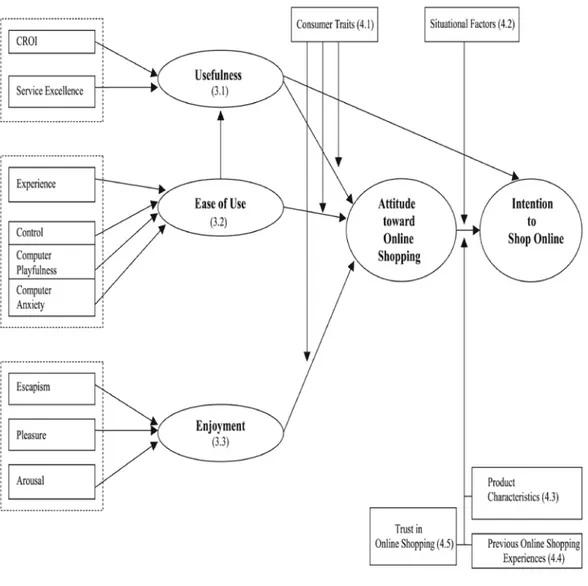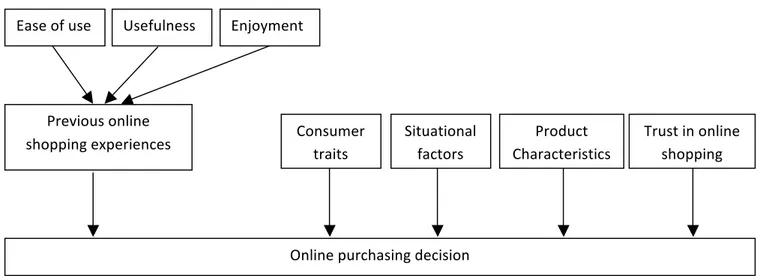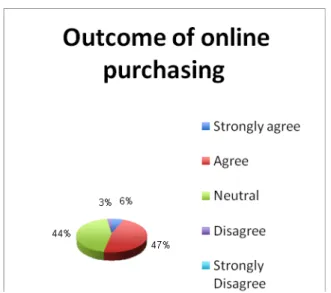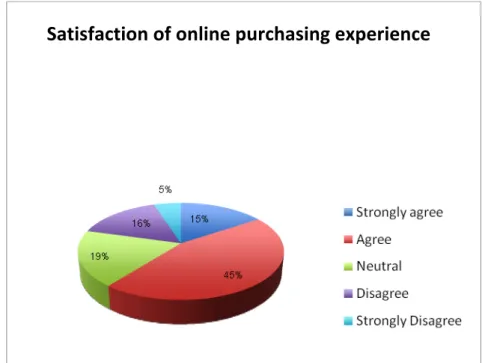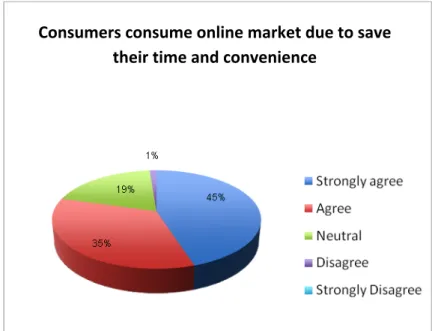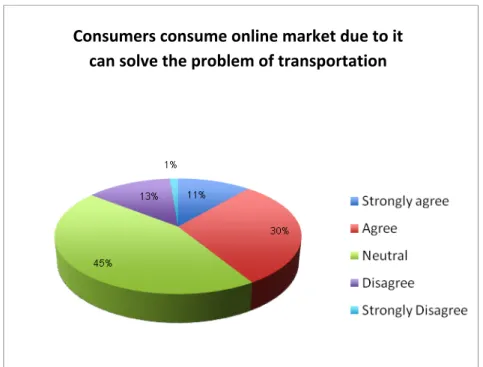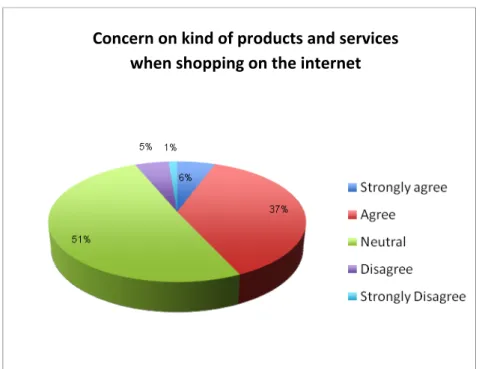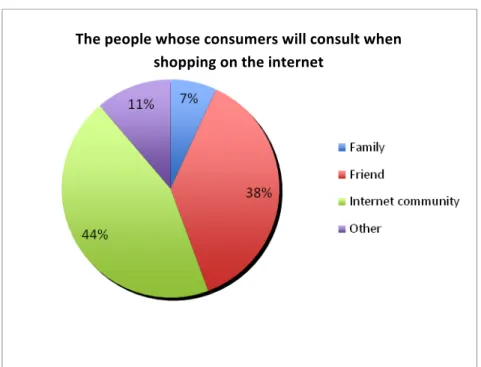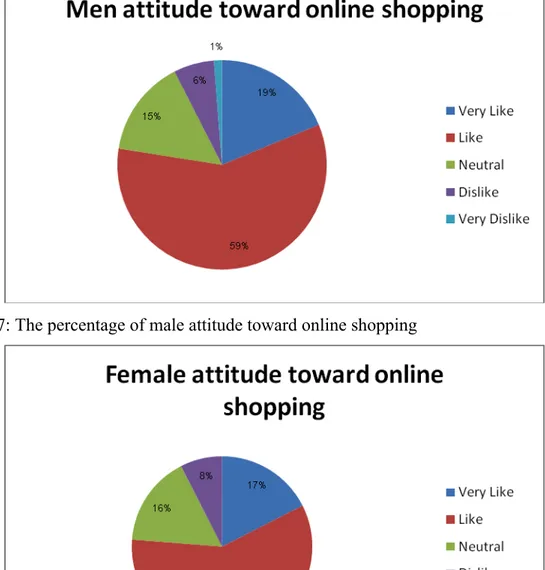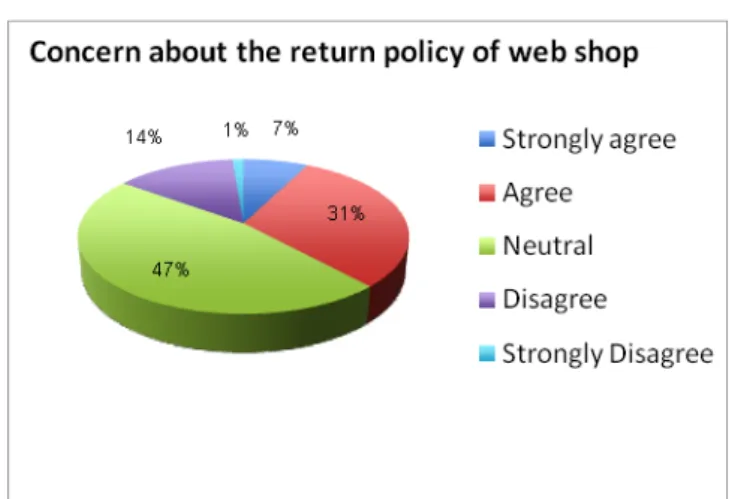International Marketing Master Thesis – EFO705
Consumer behavior toward online purchasing behavior
“What factors trigger the online purchasing decision of young Swedish consumer?”
Authors: Kaorat Thienmongkol 840902-T279 Pongsatorn Thaisuntad 811020-T210 Working group: 2308 Tutor:Daniel Tolstoy Date: June 11, 2009
ACKNOWLEDGEMENT
It is impossible to complete this study without assistance of many special individuals. Foremost, we are deeply indebted to our research supervisor, Mr. Daniel Tolstoy, for his valuable guidance and suggestions throughout the completion of this report. Next, we would like to thank all of young Swedish respondents, who have participated to complete our questionnaire.
Kaorat Thienmongkol Pongsatorn Thaisuntad Västerås Sweden June 2009
ABSTRACT
Program: MIMA student – International Marketing Course name: Master Thesis (EFO705)
Title: Consumer behavior toward online purchasing behavior Authors: Kaorat Thienmongkol
Pongsatorn Thaisuntad Supervisor: Daniel Tolstoy
Problem: “What factors trigger the online purchasing decision of young Swedish Consumer?”
Purpose: The purpose of this report is to study the insights about the factors that trigger purchasing behavior of young Swedish consumer to shopping on the internet. The result will enable managers of e-commerce firms to outline strategies to penetrate the Swedish market, and will also contribute to e-commerce literature in general. The students who study and interested in this area will be able to use this result as their empirical data and to enhance their knowledge. Method: 160 questionnaires were used as primary data. Stockholm, Goteborg, Uppsala,
Vasteras, and Eskiltuna are the cities that authors collected the data. For secondary data, authors collected data from the website.
Conclusion: Young Swedish consumers have positive experience on online shopping, trust and like to shop online. They concern on the type of product when shopping on the internet. And young Swedish consumer also effect by situational factor. Keyword: online shopping, online purchasing decision, consumer behavior
Table of Content
Chapter 1 Introduction...1
1.1 Background...1
1.2 Problem statement...1
1.3 Purpose...1
1.4 The choice of topic...2
Chapter 2 Literature review...4
2.1 Framework for consumer’s intention to shop online...4
2.2 Theoretical Framework... 10
Chapter 3 Methodology... 11
3.1 Choice of data collection... 11
3.2 Sampling... 12
3.3 Data collection... 12
3.4 Selected theories... 13
3.5 Questionnaire design... 14
3.6 Data analysis... 15
Chapter 4 Empirical data... 16
4.1 Primary data... 16
4.2 Secondary data... 28
Chapter 5 Analysis... 30
5.1 Usefulness, Ease of use, Enjoyment, and Consumer’s experience... 30
5.2 Trust on online shopping... 31
5.3 The situation factors which important to customers when shopping on internet.... 32
5.4 Consumer traits... 34
5.4.1 Gender...34
5.4.2 Education...34
5.4.3 Income...34
5.5 Product category... 35
5.6 Conclusion and recommendation... 35
5.7 Further study... 36
References... 38
Appendix... 41
List of Figures
Figure 1: Framework for consumers’ intentions to shop online ...5 Figure 2: Theoretical framework for consumer online purchasing decision... 10 Figure 3 Total amount of persons who bought or ordered in each type of products or services via the internet... 16 Figure 4: The percentage of satisfaction of consumers toward outcome of online shopping17 Figure 5: The percentage of satisfaction of consumers during the process of online shopping toward the ease of use... 17 Figure 6: The percentage of enjoyment of consumers during shopping on the internet...17 Figure 7: The percentage of satisfaction of online shopping experience...18 Figure 8: The percentage of consumers who are affected by their online shopping experience ... 18 Figure 9: The percentage of consumers who shopping online because it save the time and convenience... 19 Figure 10: The percentage of consumers who shopping online because they can not find products of services in traditional store... 19 Figure 11: The percentage of consumers who shopping online because it is able to solve the problem of transportation... 20 Figure 12: The percentage of consumers who shopping online because trust on online
shopping... 20 Figure 13: The percentage of consumers who concern on kind of products or services when shopping online... 21 Figure 14: The percentage of consumers who will buy the products or services even they can find it on the traditional store... 21 Figure 15: The percentage of the people whose consumers will consult when shopping on the internet... 22 Figure 16: The percentage of consumers who feel less risk if the web shop is recommended ... 22 Figure 17: The percentage of male attitude toward online shopping... 23 Figure 18: The percentage of female attitude toward online shopping... 23 Figure 19: The percentage of consumers who feel worry about paying with their credit card ... 23 Figure 20: The percentage of consumers who concern about the return policy of web shop24
Figure 21: The percentage of consumers who concern about the products not fitting the description made on the internet... 24 Figure 22: The percentage of consumers who feel more secure if the online shop has an offline store or well know brand... 25 Figure 23: The percentage of consumers who lack of knowledge about online shopping.... 25 Figure 24: The percentage of consumers who feel that can not test before purchase is an obstacle of online shopping ... 26 Figure 25: The percentage of consumers who want to be served by seller... 26 Figure 26: The percentage of consumers who worry about personal information security... 27 Figure 27: The percentage of respondents’ education... 27 Figure 28: The percentage of respondents’ income per month... 28 Figure 29: Percentage and number of persons in 2008 who brought the products or services from the internet... 28 Figure 30: Percentage and number of persons in 2008 broken down by how they use the Internet, age and sex... 29 Figure 31: Percentage and number of persons in 2008 by how often they use the Internet, age and sex... 29 Figure 32: Conclusion of the factors that effect to young Swedish consumer when shopping via the internet... 36
Chapter 1 Introduction
In This chapter, a brief background including problem statement and purpose of thesis are stated.
1.1 Background
Nowadays Online marketing has played important roles in business world. It is a significant marketing tool of global companies which create more value and sale volume. It also creates a great opportunity for SME to expand their business to international market since its initial capital requirement is cheaper than other expanding strategy. However, in the e-commerce market, many companies apply different online marketing strategies to each targeted country. In order to create online marketing strategy, firms need to analyze the targeted country before launching marketing strategy. Similarly to other strategies, online marketing strategies are shaped by many factors such as IT infrastructure, culture, and regulation of each country. In this paper we are interested in customer’s online purchasing behavior factor which is one important role for e-commerce firms to understand it clearly.
Sweden
According to Statistic Sweden, Sweden has ranked in the fifth place in term of selling goods or services through the internet. They stated under the topic “Use of computers and the Internet by private persons in 2008” that the proportion of Internet users increased to 84 percent which it was 69 percent in 2003. The internet is used in many different purposes such as searching for information, sending e-mail, and buying a product. More than one of three uses the Internet for e-commerce, they use internet to order goods or services (SCB, 2009).
1.2 Problem statement
“What factors trigger the online purchasing decision of young Swedish consumer?”
1.3 Purpose
The purpose of this report is to study the insights about the factors that trigger purchasing behavior of young Swedish consumer to shopping on the internet. The result will enable
managers of e-commerce firms to outline strategies to penetrate the Swedish market, and will also contribute to e-commerce literature in general. The students who study and interested in this area will be able to use this result as their empirical data and to enhance their knowledge.
1.4 The choice of topic
As we mentioned earlier in the introduction stage, online marketing is an effective tool for e-commerce firms to expand their business abroad. We decided to study about online shopping because it is mutual topic that both of us are interested. We are interested on e-commerce business because e-commerce is growing fast and profitability.
Furthermore, we decided to choose Sweden as our targeted country due to the fact that Sweden has ranked in the fifth place in term of selling goods or services through the internet. More than one of three using an internet for e-commerce, Swedish people use internet to order products and services by internet (SCB, 2009). So we are interested on that reason which we saw that this country has a very good opportunity for e-commerce firm and the people who see an opportunity.
Our target respondent will be young people age between 16-24 years old, we think this target group has high potential to make present and future profit to e-commerce firms. According to Sorce et al, they have been investigated about the attitude of people in difference age. They found that young consumers seem to be more ease to use online shopping than older people as well as in term of frequently of searching for product information (Sorce et al, 2005). So we think this group is more interesting than other groups.
1.5 Delimitation
This study was designed to find out factors that trigger the online purchasing decision of young Swedish people. Due to the limited time as we are given only ten weeks to develop and complete this report, so we will study only the factors that most effect to overall target. We will not study in some deep detail such as the difference factors between two genders, because we think that it will be better to make a new research on that area.
With the total amount of these group are 1,099,364 people, which the usage amount of this group who buy the online product are 722,132 (SCB, 2009). So it is unable to research all people in this target due to limited of time and other factors.
Finally, we scope our study base on young Swedish people who have an experience only. The experienced people are able to give us more useful and effective information than the people
who have no experience. So our study will not cover the factors that trigger the first time purchase.
Chapter 2 Literature review
This part will firstly describe the selected theory which will be used to analyse in our report. The second part will be the previous research which we have read to get an idea and to apply into our analysis part.
2.1 Framework for consumer’s intention to shop online
According to Dellaert, Monsuwe, and Ruyter (2004), they have developed the framework of Davis to use in their papers which name “Framework for consumer’s intention to shop on the internet”. Dellaert’s framework has developed from Davis’ framework or Technology
Acceptance Model (TAM). Davis built TAM to study the computer acceptance of computer-based technologies in general. In the original model, there are two factors use to measure the acceptance of user toward the new technology. Those factors are Usefulness and Ease of use (Davis et al, 1989).
Dellaert et al, found that TAM is able to apply for e-commerce as well. Then they developed it to e-commerce context as they wanted to answer their research question. Dellaert et al, added more factors which they think it relevant to e-commerce context such as Enjoyment, Trust in online shopping, and Consumer traits (Dellaert et al, 2004). Figure 1 is the model of Dellaert which developed TAM to use in e-commerce context.
Figure 1: Framework for consumers’ intentions to shop online (Source: Dellaert et al, 2004)
In our report we used only the factors that we think it relate to our research question. There are eight factors applied to use in our report which are usefulness, ease of use, enjoyment, previous online shopping experience, trust, product characteristic, situational factor, and consumer trait.
Usefulness
The usefulness originally means that individual’s performance is able to enhance by using the new technology (Davis et al, 1989). In e-commerce context, Dellaert applied it as an outcome of the online shopping experience and the effective that online shopping fulfils their task. It also refers to consumers’ perception which can enhance by outcome of online shopping. This perception can force attitude of consumers’ intention to shop online. The outcome of online shopping can raise the experience of customers (Dellaert et al, 2004).
Ease of Use
In original TAM, Ease of use referred to individual perception when using new technology with minimum of effort (Davis et al, 1989). In the modified TAM, Dellaert stated that ease of use refer to consumers’ perception during they are shopping on the internet with less effort. Ease of use is appeared during the process of online shopping which consumers like to shop on the website which is easier during the process of online shopping (Dellaert et al, 2004). According to Sorce et al (2005), they have been investigated about the attitude of people in different age. They found that young consumers seem to be more convenience to use online shopping than older people as well as in term of frequently of searching for product
information. However, the purchasing rates are similar extent. Enjoyment
According to Dellaert, (2004), enjoyment refers to the fun and playfulness during consumers shopping on the internet. Consumers want more than just completing their shopping. The feeling of consumers is the one thing that should be concerned. It also effect to consumers’ perception toward online shopping experience. The purchase of product will be the minor to consumers due to enjoyment reflect consumers’ perception.
Consumer Traits
According to Dellaert et al, (2004), stated that “Consumer traits that are of interest in to understanding why consumers shop on the internet include demographic factors and
personality characteristic”. According to Burke, there are four relevant demographic factors which are age, gender, education, and income (Burke, 2002).
First factor is gender. Gender is an important factor when study online consumer. Men are easier to accept new technology in the process of shopping. Meanwhile, female normally like to use a catalogue when they are shopping at home. Another point is female seem to have more positive feeling to use online shopping. However, women tend to use online shopping more frequently than men (Burke, 2002). In our report we study only which gender of our target prefer to shop on the internet.
Second is education factor. Education is relevant factor which exists in the consumer trait of online consumer. The consumers who have higher education are more comfortable to shop on the online market than those with lower education. (Burke, 2002).
Final determinant is incomes which also affect consumers when they purchase product or services on the internet (Dellaert et al, 2004). Higher household income consumers tend to consume online product more than lower income consumers. (Lohse et al, 2000).
Age factor was not used in our report due to we already scope our target group
to 16-24 years old.
Situational Factors
According to Delaert et al (2004), they state that situational factors are needed to be
considered in the model. It will be more obviously to understand the motivative factors that
influence to online shopping. Delaert et al (2004) pointed that the motivative factors are time pressure, lack of mobility, and geographical distance.
The convenience and accessibility are the important factor for consumer to decide to shop on the Internet. Online shopping enables consumer to shop any time and to save their time and effort. Consumer can get the product, even they have a few of free time. (Wolfinbarger and Gilly, 2001). Time pressure influences the relationship between consumer’s intention to online shopping and their attitude. However, online shopping which operating 24 hours a day lead this factor less important toward consumers’ attitude (Dellaert et al, 2004).
In addition, lack of mobility and geographical distance are focal factors for the online shopping. Online shopping can solve the problems of traditional shopping such as long distances to the store, an illness or other immobilizing reason (Dellaert et al, 2004).
Wolfinbarger and Gilly (2001) stated that consumers prefer to use online shopping because some special products cannot be found on traditional market. Dellaert et al (2004) claimed that online shopping is alternative shopping channel for consumer who cannot get the product on traditional shopping.
The last factor that affect for relationship between attitude and intention is an attractiveness of alternatives. Consumers tend to shop at traditional store rather than online shopping when the products are similar and available for them. However, positive attitude is the important factor to attract consumer to decide online shopping (Dellaert et al, 2004).
Previous Online Shopping Experiences
Experiences of shopping on the internet influence consumers’ intention to shop on the internet (Shim et al., 2001; Eastlick and Lotz, 1999; Weber and Roehl, 1999). Consumers assess their online shopping in many aspects, such as perception of production detail,
delivery terms, privacy, security, entertainment, etc. (Burke, 2002; Parasuraman and Zinkhan, 2002; Mathwick et al., 2001).
Consumers prefer to continue online shopping when they satisfy in the past experience. The perception of risks on online shopping may be decreased when consumers have a positive experience. In the contrast, the negative experiences may harmful to online market, and consumers will not buy the product again (Shim et al., 2001). In order to assure the
consumers to repeat buying online product, the satisfaction is the most importance for online shopping (Weber and Roehl, 1999).
Product Characteristics
According to Dellaert et al. (2004), the type and characteristics of the products influenced consumers’ attitudes toward online shopping. Each product presents its own characteristic that consumers think about it when they shop. Not every product is suitable for online market. There are some factors affecting to online shopping, for example, the lack of physical contact and assistance. Consumers may prefer to feel, touch, smell or try the product but they cannot do it when they shop on the internet (Dellaert et al, 2004).
Grewal et al. (2002) stated that some products such as books, CDs, groceries, and flowers are standardized and familiar products, which have more capability on online shopping than other type of products. According to their attributes do not need pre-trial or physical assistance (Grewal et al., 2002; Reibstein, 1999). Likewise, the products that involve a high level of privacy and secrecy, consumers’ intention to shop on the Internet will be high (Grewal et al., 2002).
Differently, some products such as car, perfume and lotion, their product’s attributes require personal knowledge or experience. Thus, consumers will not prefer to buy on the Internet (Elliot and Fowell, 2000). Dellaert et al (2004) supported that consumers’ intention will be low to shop on the internet on the products that require salesperson and pre-trial.
Trust in Online Shopping
According to Online shopping involving uncertainty and risk, one of the reasons that prohibits consumer to buy products on the Internet is the lack of trust (Lee and Turban, 2001).
It is challenge for consumer to purchase online since the online shopping is a new channel for consumers. Rotter (1971) has found that in narrative situations, people depend on their
general nature to trust.
Salesperson is the most important process to make the consumer confident in traditional shopping. In addition, the consumer trust depends on people skill, likeness of salesperson to consumer (Doney and Cannon, 1997). However, Lohse and Spiller (1998) argued that online shopping is able to replace salesperson by using the help of buttons and search features Lee and Turban (2001) mentioned that risk is a considerable reason because consumers cannot check some product information during shopping online such as security of delivery service and financial information.
A high level of privacy and security on online shopping experience can create the positive trust that the level of trust related to interpersonal as well as institutional. Contravention of consumers’ trust will lead to negative attitude toward online shopping regarding privacy invasion or misuse of personal information. In addition, it will lead to unwilling consumer’s behaviour on shopping online in future (Dellaert et al, 2004).
According to Holsapple et al, (2005), stated that trust is one of most important and relevant factors for company to success in E-commerce market for consumers’ products. And we found that there is other authors have investigated about trust. Choudhury et al, (2002), found that trust helps consumer willing to shopping online and help online consumers to overcome perceived risk and insecurity.
2.2 Theoretical Framework
Figure 2: Theoretical framework for consumer online purchasing decision (Source: Authors)
When we drawn the framework for this study, we think that usefulness, ease of use, and enjoyment effect to the consumer’s experience as Dellaert stated. Then, the previous online shopping experience will be used to make a decision while consumers shopping on the internet. For the other four factors- consumer traits, situational factors, product
characteristics, and trust in online shopping have directly effect to consumer’s decision.
Ease of use Usefulness Enjoyment
Consumer traits Previous online
shopping experiences Situational factors Characteristics Product Trust in online shopping
Chapter 3 Methodology
This section is an information and explanation of the methodology which we select to conduct in the report. Moreover, this section also includes brief information of the choice of topic, research method, data collection, data analysis and selected theories.
3.1 Choice of data collection
To answer and complete our research question, both Primary and secondary data will be collected. Primary data will be collected with aim to answer the research question of our report. There are two kinds of research approach which are quantitative and qualitative. Questionnaire is the one tool that uses to complete the quantitative research. It helps researcher to study attitudes, values, and perceptions. Another one is qualitative research approach which will be used to gain better understanding of respondents such as case study, participant observation, direct observation, and unstructured interviewing (Holme and Solvang, 1997). In our report we chosen questionnaire to study the factors that trigger young Swedish consumer. Secondary will be gathered at the earlier stage due to it will fulfill the purpose of some other study. This data is available on many sources such as books, articles, thesis, and so on (Saunders et al, 2007).
Primary data
In our report we propose to find out the factors that force young Swedish people to shop on the internet. We think that the existing information and data are not enough to analyze, conclude, and answer our research question. It is limited information of young Swedish people age between 16-24 years old. So for primary data, we will collect quantitative data via questionnaire. Questionnaire is an effective quantitative method which can collect large amount of quantitative data. Due to our target group is young Swedish people, 1,099,364 people, so this method will be suitable for us to investigate in large portion of the population than using qualitative research. 160 of young Swedish people will be the sample size to our questionnaire which each gender will be collected for 80 questionnaires to make it more reliable. Due to some respondent may not complete all question in our questionnaire, so we are collecting 200 respondents to prevent the error that might happen.
The criteria that we used to source out 40 questionnaires based on the amount of error that we found and making the balance between two genders.
After we collected data we found that 35 questionnaires were error. Firstly, there were 26 people who had no experience on online shopping but actually we focused on the respondents who have experienced on online shopping. Another nine respondents did not answer their personal information such as income. So the total usable data were 165 which 85 were female and 80 were male. Then, as we mentioned above we decided to source out 5 female respondents to balancing both gender. We used sampling method to source out those 5 exceed questionnaires of female. So we have 160 questionnaires which both gender were balanced.
Secondary data
For the secondary data, our sources are based on browsing the webpage to collect some related information. We will search both quantitative and qualitative information via this channel. We collect statistic data, existing journal, and any related information to complete our report and make it more reliable.
3.2 Sampling
As we mentioned above our 200 respondent, only 160 will be used to prevent the error. To make it more reliable, it will be divided to 80 respondents for each gender. Finally, all respondent must be the people who have experienced on online shopping.
3.3 Data collection
Due to our report has to represent the outcome for all young Swedish people, so the other way to cover the reliable of outcome is to collect data from five cities which are Stockholm, Goteborg, Uppsala, Vasteras, and Eskiltuna. The cities that we choose base on size of population and potential to collect data.
Stockholm is the capital city of Sweden, which has the biggest population (SCB, 2009). The capital city is most important to do research due to it represent many factors of Sweden such as fashion, technology, and national culture. Goteborg is the big city which the people age between 18-24 years old is 52,781 peoples (SCB, 2009). This is very large amount when comparing with other city. Young Swedish people who live in Uppsala will be collected to complete our study. Uppsala is city which have the famous university, Uppsala University, and the amount of target also in the high rank when compare with other city. So we think that Uppsala is the good city that we use to collect data. Vasteras can represent as the city that we
live, so it is convenience for us to collect data by ourselves. Furthermore, the population in this city is also in the high rank. Finally, Eskiltuna is the city that we choose. This city is convenience for us to collect data and one more important factor is to have more cities to collect data which will be more reliable to the reader.
We will collect data at Stockholm by ourselves. 80 respondents will be collected in this city due to it is the capital city as we mentioned earlier. We will collect data in Stockholm University for 40 respondents, which the left amount will be collected at the city centre. Goteborg respondents will be collected for 10 people due to we got the contact from our friends that they guarantee to help us to collect this data. 10 respondents will be collected in Uppsala by our friends as well. This amount is guaranteed by them that they can collect it. We will collect 40 questionnaires in Vasteras due to we are able to collect it by ourselves. We will collect data at Malardaren University and the city centre. Finally, Eskiltuna will handle the left amount of it. 20 respondents will be collected by us. We divide the proportion of questionnaire based on the potential of collecting process. Stockholm is the capital city and we can spend time on there to collect data, meanwhile, the other two big city, Goteborg and Uppsala is quite difficult to us when collect data. So we divide it with less proportion to make sure that we can get the feedback. However, we will collect 200 questionnaires as we
mentioned earlier, so 40 reserved questionnaires will be divide base on the factors on the time that we collect.
3.4 Selected theories
To analyze and answer the research question, the research has focus on “Online Marketing”, which concerns “New Generation toward online purchasing behaviour”. The following literature will be used and references to the research.
As we have searching for many theories we found that the “Framework for consumer’s intention to shop online” by Dellaert, Monsuwe, and Ruyter, (2004), is very useful to answer our research question. We have chosen to use this model because it relates to computer knowledge, and positive and negative issues with online shopping. It will be applied as a foundation for designing our questionnaire. The framework will support us when analyzing empirical data and answer the research question.
3.5 Questionnaire design
As we mentioned that our report will be completed by using questionnaire as a main method. Our questionnaire was built to answer the research question. We designed the questions based on the applied theory.
Question 1 was designed to screen the people whether they have an experience or not. If they have no experience, they do not have to continue on the next question.
In the question 2, we want to know which kind of products and services that young Swedish people decided to buy from internet. The categories of products and services were applied from the statistic of “percentage and number of persons in 2008 who bought or ordered products or services via the internet for private use during the past year categorized by what was bought /ordered and sex. The figure will be shown in the appendix part.
To measure what factors that young Swedish concern when purchasing product from internet, so question 3 was designed to answer that point. The result will be used to analyse those people how they think about that outcome of online purchasing, how important of the process during they shopping on the internet, and how important of their feeling when they are
shopping.
Question 4 and 5 will be used together when analysing. We would like to know whether the previous online shopping experience have an affect/ force the young Swedish people to buy products or services on the internet again.
The result of question 6 will tell us how important of each factor that forces them to buy the products or services online. Meanwhile, question 7 will be collected to answer that if the product or services are existing on the traditional market, do they still shopping on the internet or not.
Question 8 will measure how people try to decrease their risks while shopping on the internet. And question 9 will be explored whether people do prefer to shopping online or not.
To indentify the obstacles and the difficulties when people buy the products or services on the internet, we design that factor to measure how much important of each one.
Final section we want to collect the personal detail which will relate to the theory in part of consumer trait. The result will be used with some upper questions. The full format of questionnaire is shown in the appendix.
3.6 Data analysis
In order to analyse the data, we have to interpret our 160 questionnaires to be usable data by statistical software program which is Microsoft excel. We will show that data in table, charts and pie charts which are easier both for us and reader to understand. After having usable data, we will analyse it with the theory that we selected. We will apply the data to use in analysis, conclusion, and recommendation part which the result will answer to our research question which of the factors that are important and trigger to young Swedish people when shopping online. It also generate to some other related points which we will use in conclusion and recommendation part.
Chapter 4 Empirical data
In this section, the empirical data is collected and described from method collection in chapter two. The data will be divided into two parts. The first part is the primary data which we collect by questionnaire as we mentioned earlier. The next one is the secondary data which we collect it via the existing sources.
4.1 Primary data
Figure 3: Total amount of persons who bought or ordered in each type of products or services via the internet.
Figure 4: The percentage of satisfaction of consumers toward outcome of online shopping
Figure 5: The percentage of satisfaction of consumers during the process of online shopping toward the ease of use
Figure 7: The percentage of satisfaction of online shopping experience
Figure 8: The percentage of consumers who are affected by their online shopping experience
Satisfaction of online purchasing experience
Does online purchasing experience effect to
consumers purchasing decision?
Figure 9: The percentage of consumers who shopping online because it save the time and convenience
Figure 10: The percentage of consumers who shopping online because they can not find products of services in traditional store
Consumers consume online market due to they can not find the product or services from
traditional store
Consumers consume online market due to save their time and convenience
Figure 11: The percentage of consumers who shopping online because it is able to solve the problem of transportation
Figure 12: The percentage of consumers who shopping online because trust on online shopping
Consumers consume online market due to it can solve the problem of transportation
Figure 13: The percentage of consumers who concern on kind of products or services when shopping online
Figure 14: The percentage of consumers who will buy the products or services even they can find it on the traditional store
Concern on kind of products and services when shopping on the internet
Consumers who will buy the products or services even they can find it on the traditional store
Figure 15: The percentage of the people whose consumers will consult when shopping on the internet
Figure 16: The percentage of consumers who feel less risk if the web shop is recommended
The people whose consumers will consult when shopping on the internet
Figure 17: The percentage of male attitude toward online shopping
Figure 18: The percentage of female attitude toward online shopping
Figure 20: The percentage of consumers who concern about the return policy of web shop
Figure 21: The percentage of consumers who concern about the products not fitting the description made on the internet
Figure 22: The percentage of consumers who feel more secure if the online shop has an offline store or well know brand
Figure 24: The percentage of consumers who feel that can not test before purchase is an obstacle of online shopping
Figure 26: The percentage of consumers who worry about personal information security
Figure 28: The percentage of respondents’ income per month
4.2 Secondary data
Age Percent absolute numbers
Total Men Women Total Men Women
16-24 years 67 72 62 722,132 397,738 324,394 25-34 years 70 74 65 798,640 432,878 365,762 35-44 years 64 65 64 835,968 431,040 404,928 45-54 years 55 56 54 646,481 334,833 311,648 55-64 years 37 42 31 448,069 257,627 190,442 65-74 years 17 21 14 143,706 82,537 61,169 Total 53 57 50 3,594,996 1,936,653 1,658,343
Source by Statistiska Centralbyran (SCB, 2009)
Figure 29: Percentage and number of persons in 2008 who brought the products or services from the internet.
Age Where Percent absolute numbers
Total Men Women Total Men Women
16-24 years At home 93 94 92 1,003,049 520,263 482,786
The workplace 22 24 20 238,520 132,497 106,023
In school 56 51 61 600,439 280,093 320,345
In someone else's home 44 45 42 469,302 248,579 220,723
Somewhere else 21 25 17 230,029 140,452 89,578
Source by Statistiska Centralbyran (SCB, 2009)
Figure 30: Percentage and number of persons in 2008 broken down by how they use the Internet, age and sex
Age How often Percent absolute numbers
Total Men Women Total Men Women
16-24 years By and large every day 86 91 82 930,608 502,315 428,293
At least once a week 11 7 14 113,896 40,602 73,295
At least once a month 1 1 1 9,072 5,075 3,996
Less than once a month 0 0 1 4,841 2,018 2,823
Source by Statistiska Centralbyran (SCB, 2009)
Figure 31: Percentage and number of persons in 2008 by how often they use the Internet, age and sex
Chapter 5 Analysis
In this part, we are going to analyze our report by using our selected theory, and then link it with both primary data and secondary data that we collected.
5.1 Usefulness, Ease of use, Enjoyment, and Consumer’s experience
Usefulness refers to the outcome of online shopping (Dellaert, 2004). As the result of the primary data that we collected, 6% are strongly agree and 47% agree that outcome of online shopping is important as they have an experience. When comparing with other answer, 44% are neutral, and the less are disagree, so we can see that the outcome of online shopping is quite important to young Swedish people.
According to Davis, ease of use refers to when individual perceive the using new technology with free of effort. The most respondents answer that they agree that online shopping is easy to use. With 49% of respondents agree and 24% are strongly agreed, so young Swedish consumers feel easy when shopping on the internet. According to previous research of Sorce, they mentioned that young consumers feel more convenience to use online shopping than older people (Sorce, 2005). So we can see that age is one factor that force young Swedish consumers feel easy to use during buying products and services on the internet.
Enjoyment is one factor that we mentioned. 51% of young Swedish consumers agree that they are enjoyed during purchasing product on the internet. The less are neutral with 29% and 20 % for strongly agreed. So young Swedish consumers feel very enjoy when they shopping on the internet.
As the result of Usefulness, Ease of use, and Enjoyment, most of young Swedish consumers satisfied and concerned on these points. According to Dellaert, Usefulness will raise the outcome of customers’ experience (Dellaert, 2004), ease of use and enjoyment also effect to consumer’s experience as we mentioned above. We have assumed that if young Swedish people have positive attitude on this point, they might feel that they have a good experience. As the result of the questionnaire, most people satisfied on their experience. There are 45% satisfied on their purchasing experience and 15% are strongly agree. So there is a relation between those three factors and consumer’s experience which outcome is the same way. Most young Swedish consumers have positive experience toward online shopping.
According to Shim, 2001, experiences are able to influence consumers’ intention to shopping on the internet. It also have direct impact on the next shopping (Eastlick et al, 1999: Weber et al, 1999) and consumers tend to continue and repeat to buy products and services online due
to their experience (Shime, 2001: Weber et al, 1999). As we got a result that 64% of young Swedish consumer will shop on the internet again due to their satisfied experiences. So the results of young Swedish consumer are similar to the theory that we have used.
5.2 Trust on online shopping
Young Swedish consumers tend to trust on online shopping. As the result of questionnaire, 51% agree that they trust on online shopping. 22% are neutral and 8% are strongly agreed. So there are just only 19% of young Swedish consumer feel negative on this factor. Although the online shopping involves more uncertainty and risk than traditional shopping as Lee has mentioned (Lee et al, 2001), but most of young Swedish consumer still trust on online shopping.
According to Dellaert, the positive trust is created by the decreasing of risk involved in exchanging information (Dellaert et al, 2004). Support by salesperson, checking product before buying, secure of delivery services, financial information, and personal information are the factors that effect to level of trust of online consumers (Lee et al, 2001: Dellaert et al, 2004). When young Swedish consumers want to decrease their risk on online purchasing, one way that can help them is to create more trust by consulting with other people. As the result of questionnaire, 44% of young Swedish consumer will find the support via the internet community, 38 % talking with their friends, their family and other sources. Internet community contains much more information for internet users. They are able to find both positive and negative opinions in this kind of community. Friends are the group which young people like to spend their time with, so that might be the reason for young Swedish consumer to find the information from these sources as the top rank. Many Swedish consumers are affected by friend or other people recommendations. 11% are strongly agreed and 47% are agreed that they feel less risk if a website is recommended by friend or other.
Young Swedish consumer feel less risk if a web site has their own offline store and well known brand. There are 62% of respondents who agreed on this point and 22% strongly agreed on it. “Cannot test the product” is the obstacle that forces young Swedish consumers to have more risk. There are large portion of people think that this is the biggest problem when shopping online. Young Swedish consumers also want to be served by seller as a major factor that online shopping lack on it. 39% are agreed and 25% are strongly agreed on this factor. The other important factor is security of personal information. Young Swedish
strongly agreed, there is no respondents rejected on this part. So the security of personal information is the important thing that website should gain trust on it in order to decrease risk of online shopping.
The other factor is about the using of credit card, policy of website, and concern on product will not fitting as in the website also effect to consumers’ trust. But these factors are not much concerned as above factors due to there are many respondents are disagreed and neutral on this one.
According to the Rotter, 1917, online shopping is quite a new channel for consumers which have few experiences and challenge to many customers to shop online. Young Swedish consumer mostly disagree that they are lacked of online shopping knowledge. There are 43% of respondents disagreed on this point. So this factor is not the main factor which young Swedish consumers are affected.
5.3 The situation factors which important to customers when shopping on internet. In the beginning of doing this paper, we assumed that the situational factors are important to consumer when shopping on the internet. We would say that we agree with TAM model during we have read their theory. However, each market is different so it is worth to investigate whether this assumption is right and important to concern when enter to this target.
According to Delaert, situational factors including time pressure, lack of mobility and geographical distance, need for special items, and attractiveness of alternatives. (Delaert, 2004). We will use the data from the questionnaire to analyze in this part which questionnaire 6 and 7 will be use. “Save my time and convenience” will be referred as the convenience, accessibility and time pressure in the theory of TAM. “Cannot find what I want from the traditional store” is used to analyze “need for special item” of young Swedish people. “Solve the problem of transportation” useable for lack of mobility and geographical distance. And finally, question 7, “If products or services are available on the traditional market I will buy it from the internet” will be use to related with attractiveness of alternatives.
As we collected and interpreted data in previous part, we found that most of young Swedish people are strongly agreed and agreed with the benefit of online shopping that save their time and create more convenience. 45% of respondents are strongly agree and 35% agreed on this. There are just only 1% disagree on this factor with the less, 19% feel neutral. So this factor is very important to young Swedish consumers when they decide to shopping on the internet.
According to Delaert mentioned that these factors are the most important for consumer toward online shopping. They are able to shopping anytime as they want even in the late night. So we would see that the assumption of TAM can be applied to this type of consumers which also concern on convenience and time as major factor.
Next we will analyze the needs for special items. The result of questionnaires shows that most young Swedish consumers feel neutral on this factor. There are 53% of respondents’ answers on neutral. The consumer also feel strongly agree and agree on this factor with 14% and 17% following. Meanwhile there are 14% disagreed and 2% feel strongly disagreed on the needs for special item. We think that the large group who answer neutral might not concerned about this too much due to they may brought it by other reasons. However they also think this factor is also important. So we would analyze that the needs for special item is important to young Swedish consumer, but not much. Due to the amount of target who at least agree have more amount than the negative answers. It can be referred to Dellaert who mentioned that online market is the one way that consumer use to fulfill their need when they cannot effort on traditional store. Young Swedish consumers may use online market when traditional market do not support. But this factor is not much concern, as we mentioned above.
The third situational factor is Lack of mobility and geographical distance. As we mentioned it will be referred to “solve the problem of transportation” in question 6. The data show that 45% of respondent feel neutral, 30% are agree, 11% strongly are agree, 13% are disagree, and 1% are strongly disagree. Although the large proportion is the group of people who feel neutral, but the people who answer strongly agree and agree also have high rate. When
comparing all data together, we think that this factor is also important to consumers’ decision. Final situational factor is use to analyze with question 7 in questionnaire. As we see in the result of questionnaire that most people think that if the products or services are available on traditional market they also buy it from the internet. 53% agree with this point. There are quite large group feel not sure on this. So our analysis would argue what Dellaert has said. Dellaert mentioned that people prefer to shop on traditional store rather than online store. But as the result of questionnaire show that young Swedish people still like to buy it via internet when comparing with traditional store.
So we would say that the time pressure, convenience and accessibility are the most important factors which force them to shopping online.
5.4 Consumer traits 5.4.1 Gender
Gender is also important to measure the attitude of consumer to complete online shopping. Men are easier to adopt new technology in the process of shopping. Meanwhile, female normally like to use a catalogue when they are shopping at home. Another point is female seems to have more positive feeling towards online shopping. However, women tend to use online shopping more frequently than men (Burke, 2002).
According to Burke, he mentioned that gender is one important factor which is able to force consumer’s attitude to shopping via the internet which men and women are difference (Burke, 2002). As we have collected and interpreted the data, the results shown that most of men like to shopping online. 59% of male like and 19% are very like to shopping via the internet. When comparing the results of male with female, we analyze that both genders are quite similar. Because the percentage of female who like to shop online is equal to the percentage of male which is 59%. The other percentages are also quite similar. So there is no difference between male and female of young Swedish people in term of their attitude toward online shopping.
5.4.2 Education
According to Burke, consumers who have higher education will be more comfortable in using online store (Burke, 2002). When we got the result of questionnaire, we found that every respondent have a good education. There is no people has education lower than high school and most people study in the university. So they have enough knowledge in using the internet and online shopping. As we mentioned above that young Swedish consumer avoid that knowledge is their obstacle when shopping via the internet. So in this part we analyze that young Swedish consumers age between 16-24 years old have high education which lead them feel comfortable when shopping via the internet.
5.4.3 Income
Final determinant is incomes which also affect the relationship with those other factors and attitude of consumer towards online shopping (Dellaert et al, 2004). Higher household income consumers with above $75,000 annually income tend to consume online product rather than those lower income consumers. There are relationship of higher income consumer
are often positively relate with possession of computer, also consumers internet access and higher level of education (Lohse et al, 2000).
According to Lohse et al, they mentioned that consumers who have more income intend to shop via the internet rather than lower income (Lohse et al, 2000). Most young Swedish consumers have income between 10,001-15,000 krona per month, and most of them have enough incomes which lead them to intend to shop via the internet.
After we analyzed three factor of consumer trait, we found that there is no difference between male and female. All of them have good education and income which lead young Swedish consumers intend to shop via the internet.
5.5 Product category
According to Dellaert et at, they mentioned that it is not all kind of products that are suitable for online shopping. Consumers also need five senses when they shopping. So some products are very suitable for online shopping and some products do not (Dellaert et al, 2004). The result of questionnaires shown that young Swedish consumers preferred to consume the products and services that they feel similar and do not require too much sense such as booking travel and accommodation, buying ticket, magazine, and film via the internet. Meanwhile some products are required other senses or needs to be tested before purchasing such as food, furniture, and home electronic do not popular to young Swedish consumer. So product characteristic is one important factor that young Swedish people also concerned when making a decision.
5.6 Conclusion and recommendation
Young Swedish consumers age between 16-24 years old have positive experience which is one important factor that help them make decision when they make decision on the next purchase. They have positive attitude towards three factors behind their experience which are ease of use, usefulness, and enjoyment. So it is easier for the e-commerce firms to enter to this market due to consumers have good attitude on this channel. However, both new and existing companies have to concern that experience of consumer is very important, so
companies must make customer have a good experience when they shopping on the website. Both male and female prefer to shop on the internet with the similar percentage. Good
education and income. For the situational factors, young Swedish consumers are affected by these four factors as we mentioned earlier. So it is opportunities for company to fulfil and solve this problem to this target. There is one more opportunity to firms which is young Swedish people trust to buy products or services via internet. Finally, product characteristic is the important factor that company should concern. They should analyze their product before launching to this market.
Figure 32: Conclusion of the factors that effect to young Swedish consumer when shopping via the internet.
Source: author
5.7 Further study
It will be more completed to this research if gender has studied in deep detail. Although the result shown that both genders like to shop online, but we believe that there probably are some differences between male and female such as products and services that each gender prefer to buy via internet. So we think that the difference between genders is an interesting topic for the further study.
Purchasing decision is another topic that should study to complete the process of online consumer purchasing. As we have find out the factor that trigger young Swedish consumer to purchase online products and services, so the activity during they consume online shopping should be studied such as how long they spend their time on the internet, what is the most
popular online shopping website, and what is the appropriate website layout for online shopping.
References
Burke, R.R. (2002). Technology and the consumer interface: what consumers want in the physical and virtual store. Journal of the Academy of Marketing Science, 30(4), 411-432. Choudhury, V., Kacmar, C., & McKnight, D. (2002). Developing and validating trust measures for E-commerce: an integrative typology. Information systems research, 13, 334-359.
Davis, F.D. (1989). Perceived usefulness, perceived ease of use, and user acceptance of information technology. MIS Quarterly, 13(3), 319-340.
Dellaert, B.G.C., Ruyter, K., Monsuwe´, T.P. (2004), What drives consumers to shop online? A literature review, International Journal of Service Industry Management, Vol. 15 No. 1, 2004 pp. 102-121.
Doney, P.M., & Cannon, J.P. (1997). An examination of the nature of trust in buyer-seller relationships. Journal of Marketing, 61(2), 35-51.
Eastlick, M.A., & Lotz, S.L. (1999). Profiling potential adopters of an interactive shopping medium. International Journal of Retail and Distribution Management, 27(6/7), 209-223. Elliot, S. and Fowell, S. (2000), “Expectations versus reality: a snapshot of consumer experiences with Internet retailing”, International Journal of Information Management, Vol. 20 No. 5, pp. 323-36
Grewal, D., Iyer, G.R. and Levy, M. (2002), “Internet retailing: enablers, limiters and market consequences”, Journal of Business Research.
Holme I. & Solvang B.I. (1997). Research method: quantitative and qualitative methods, student literature AB. Lund
Holsapple, C., & Sasidhara, A. (2005). The dynamics of trust in B2C E-commerce. ISeB. 3. 377-403.
Lee, M.K.O., & Turban, E. (2001). A trust model for consumer Internet shopping. Interna-tional Journal of Electronic Commerce, 6(1), 75-91.
Lohse, G.L. and Spiller, P. (1998), “Electronic shopping”, Communications of the ACM, Vol. 41, No. 7, pp. 81-7.
Lohse, G.L., Bellman, S., & Johnson, E.J. (2000). Consumer buying behavior on the Inter-net: findings from panel data. Journal of Interactive Marketing, 14(1), 15-29.
Mathwick, C., Malhotra, N.K., & Rigdon, E. (2001). Experiential value: conceptualization, measurement and application in the catalog and Internet shopping environment. Journal of Retailing, 77(1), 39-56.
Parasuraman, A. and Zinkhan, G.M. (2002), “Marketing to and serving customers through the Internet: an overview and research agenda”, Journal of the Academy of Marketing Science, Vol. 30 No. 4, pp. 286-95.
Reibstein, D.J. (1999), “Who is buying on the Internet, 1999?” Working Paper, The Wharton School, University of Philadelphia, Philadelphia, PA.
Rotter, J.B. (1971), “Generalized expectancies for interpersonal trust”, American Psychologist, Vol. 26 No. 5, pp. 443-52.
Saunders, M. N. K., Thornhill, A., Lewis, P. (2007). Research Methods for Business Students. London: Pearson Higher Education.
Shim, S., Eastlick, M.A., Lotz, S.L., & Warrington, P. (2001). An online prepurchase inten-sions model: the role of intention to search. Journal of Retailing, 77(3), 397-416.
Sorce, P., Perotti, V., & Widrick, S. (2005). Attitude and age differences in online buying. International journal retail & distribution management. 33(2). 122-132.
Weber, K., & Roehl, W.S. (1999). Profiling people searching for and purchasing travel products on the world wide web. Journal of Travel Research, 37(3), 291-298.
Wolfinbarger, M., & Gilly, M.C. (2001). Shopping online for freedom, control, and fun. California Management Review, 43(2), 34-55.
Internet sources
SCB. (2008), Population statistics. Retrieved March 16, 2009, from
http://www.scb.se/Pages/TableAndChart____262460.aspx/
SCB. (2008), ICT usage in households. Retrieved March 16, 2009, from
http://www.scb.se/Pages/TableAndChart____201818.aspx/
SCB. (2009), Population statistics, Retrieved March 16, 2009,
fromhttp://www.scb.se/Pages/TableAndChart____25891.aspx/
SCB. (2008), ICT usage in household, Retrieved March 16, 2009, from
http://www.scb.se/Pages/TableAndChart____201816.aspx
SCB. (2008), Use of computers and the Internet by private persons in 2008, Retrieved March 16, 2009, from
http://www.scb.se/Pages/PublishingCalendarViewInfo____259924.aspx?PublObjId=8415
SCB. (2008), Population statistics. Retrieved March 16, 2009, from
http://www.scb.se/Pages/TableAndChart____159278.aspx
Appendix I. Questionnaire
This questionnaire is used for a research entitled “Consumer behavior toward online purchasing behavior” which focuses on young Swedish people age between 16 to 24 years old. It is done within study program for Master’s Degree in International
Marketing at Mälardalen University, Västerås, Sweden. The information provided by the respondents will be used for academic purposes only and will not be given to any other person, your answer are anonymous.
1. Have you ever brought products or services from Internet? __ Yes (Please continues this questionnaire)
__No (Thank you for your attention, but we are collecting data of people who have an experience only.)
2. What kind of products or services that you have ever brought? (you can answer more than one)
a. Food or groceries
b. Household items such as furniture or toys c. Films or music
d. Books, magazines or computer-based study materials e. Clothes or sporting goods
f. software or computer games
g. Computers or computer accessories h. Home electronics
i. Shares, insurance or other financial services j. Travel or accommodation
k. Tickets to events l. Lotto, gambling
3. Due to your experience, please rank your scale
Strongly
agree
Agree Neutral Disagree Strongly Disagree
Outcome of online purchasing Buying product from online market is easy to use
Feel enjoy during purchase product on internet
4. I satisfy on my online purchasing experience a. Strongly agree
b. Agree c. Neutral d. Disagree
e. Strongly disagree
5. I will buy the products or services again a. Yes
b. No
c. May be
6. I decide to shopping on the internet due to
Strongly
agree
Agree Neutral Disagree Strongly Disagree
save my time and convenience can not find what I want from the traditional store
solve the problem of transportation
Trust on online shopping
7. If products or services is available on the traditional market I will buy it from the internet
a. Yes b. No c. May be
8. Who do you talk to when shopping on internet to gain the support information?
a. Family
b. Friend
c. Internet community
d. Other………..
9. How do you feel about online shopping? a. Very Like
b. Like c. Neutral d. Dislike e. Very Dislike 10. Please, rank your scale
Strongly
agree
Agree Neutral Disagree Strongly Disagree
Worry about paying with your credit card online
Concern about the return policy of web shop
Concern about the product not fitting the description made on the Internet
Feel more secure if the purchase is made from a company that has an offline store or if the purchase is a well known brand
Feel less risk if a web shop is recommended by a friend or other people
Worry about the personal information might be used for inappropriate purposes
Lack of knowledge about online shopping
Can not test product and service before purchase
Want to be served by seller
Personal information 11. Gender a. Male b. Female 12. Education a. Elementary or None b. Secondary school c. High school d. Bachelor e. Post graduate 13. Income per month
a. Lower than 5,000 b. 5,000-10,000 c. 10,001-15,000 d. Over than 15,000
II. Additional statistic
Figure 2: Percentage and number of persons in 2008 who bought or ordered products or services via the Internet for private use the past year by what was bought/ordered and sex
Product/service Percent absolute numbers
Total Men Women Total Men
Food or groceries 2 2 2 153,171 78,870
Household items such as furniture or toys 7 8 7 505,505 265,567
Films or music 16 20 12 1,080,678 682,380
Books, magazines or computer-based study materials 19 18 20 1,272,905 601,637
Clothes or sporting goods 18 14 22 1,201,544 468,752
software or computer games 8 12 4 531,270 394,148
Computers or computer accessories 10 15 5 664,678 497,698
Home electronics 11 15 6 711,541 524,481
Shares, insurance or other financial services 8 11 5 541,492 378,697
Travel or accommodation 27 29 26 1,846,943 975,469
Tickets to events 22 24 20 1,513,073 832,732
Lotto, gambling 5 9 2 369,846 311,835
